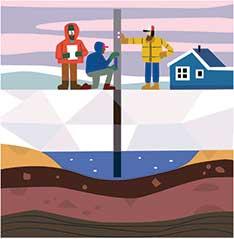Ching-Yao Lai *18’s boundless curiosity has led her on an unorthodox career path. After earning a bachelor’s degree in physics, she switched to mechanical engineering for her Ph.D. at Princeton. As she completed her degree, she found herself longing to work in a field where she could study climate change. With the encouragement of her adviser, Professor Howard Stone, she took another sharp turn and secured a postdoctoral fellowship in earth science at Columbia University. “It was more fun than choosing the safe pathway,” Lai says.
Today, Lai is an assistant professor of geosciences and atmospheric and oceanic sciences at Princeton. Putting her expertise in physics and engineering to use, she takes a multidisciplinary approach to scholarly contributions on topics as varied as ice shelves in Antarctica and partial differential equations.
Lai’s Work: A Sampling
Ice Flowing
Sea levels are rising because of ice melting in places such as Antarctica and Greenland. Scientific understanding of how ice flows is based on decades-old laboratory studies, but a block of ice in a lab may not behave the same way as ice shelves above the ocean that span hundreds of kilometers. Using satellite data that became available in the past decade, Lai uses an approach called physics-informed deep learning to understand the physical laws that govern the dynamics of glacial ice. Her project was one of nine selected in 2021 to receive support from Princeton’s Dean for Research Innovation Funds, awarded to early-stage projects.
Greenland Blisters
In Greenland, melting of the ice surface due to atmospheric warming causes lakes to form on the surface of the ice sheet. When they drain, they form large water-filled cavities known as blisters. Lai and other researchers discovered that the blisters push the surface of the ice upward, then cause it to gradually drop down as the water drains through networks at the base of the ice sheet. They created a model for measuring how much the rise and fall of the ice sheet is affected by the water networks that form between the ice and the bedrock. The findings could help explain the effects of climate change on Greenland’s frozen interior.
Machine Learning and Math
Lai’s collaboration with mathematics professor Tristan Buckmaster, who is now at the University of Maryland, came about when they met on Zoom to discuss an undergraduate math major who was doing a junior independent project with Lai. Buckmaster asked Lai about her work developing a machine-learning model; he thought the approach might help solve a centuries-old math problem related to partial differential equations and fluid dynamics. “It’s proven to be a very powerful method to solve the problem, and nobody has done it before,” Lai says. “It’s a great example of the value of talking to scholars in fields that are seemingly not connected to yours. It has turned out to be one of the most exciting projects I have.”




